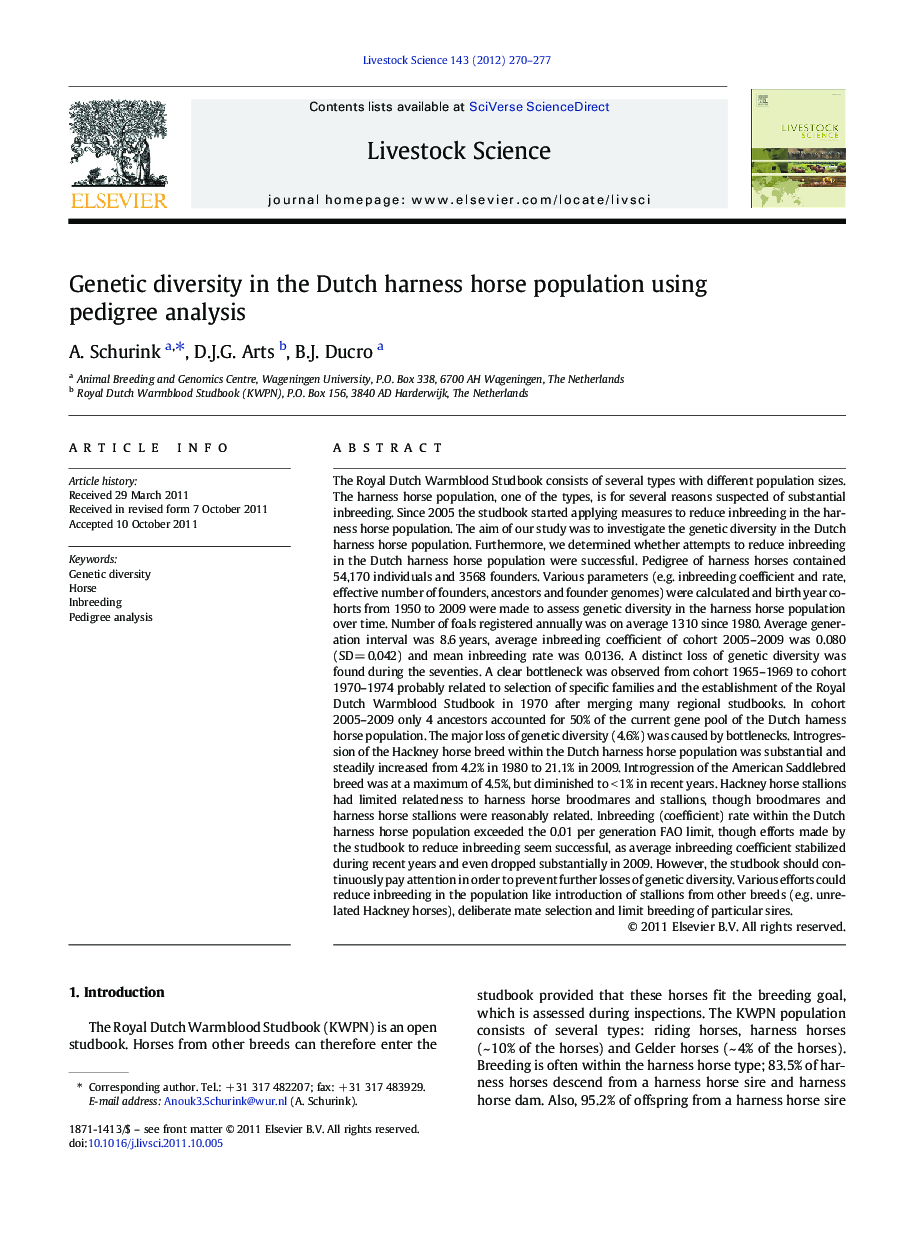| کد مقاله | کد نشریه | سال انتشار | مقاله انگلیسی | نسخه تمام متن |
|---|---|---|---|---|
| 5790806 | 1553989 | 2012 | 8 صفحه PDF | دانلود رایگان |
عنوان انگلیسی مقاله ISI
Genetic diversity in the Dutch harness horse population using pedigree analysis
دانلود مقاله + سفارش ترجمه
دانلود مقاله ISI انگلیسی
رایگان برای ایرانیان
کلمات کلیدی
موضوعات مرتبط
علوم زیستی و بیوفناوری
علوم کشاورزی و بیولوژیک
علوم دامی و جانورشناسی
پیش نمایش صفحه اول مقاله

چکیده انگلیسی
The Royal Dutch Warmblood Studbook consists of several types with different population sizes. The harness horse population, one of the types, is for several reasons suspected of substantial inbreeding. Since 2005 the studbook started applying measures to reduce inbreeding in the harness horse population. The aim of our study was to investigate the genetic diversity in the Dutch harness horse population. Furthermore, we determined whether attempts to reduce inbreeding in the Dutch harness horse population were successful. Pedigree of harness horses contained 54,170 individuals and 3568 founders. Various parameters (e.g. inbreeding coefficient and rate, effective number of founders, ancestors and founder genomes) were calculated and birth year cohorts from 1950 to 2009 were made to assess genetic diversity in the harness horse population over time. Number of foals registered annually was on average 1310 since 1980. Average generation interval was 8.6Â years, average inbreeding coefficient of cohort 2005-2009 was 0.080 (SDÂ =Â 0.042) and mean inbreeding rate was 0.0136. A distinct loss of genetic diversity was found during the seventies. A clear bottleneck was observed from cohort 1965-1969 to cohort 1970-1974 probably related to selection of specific families and the establishment of the Royal Dutch Warmblood Studbook in 1970 after merging many regional studbooks. In cohort 2005-2009 only 4 ancestors accounted for 50% of the current gene pool of the Dutch harness horse population. The major loss of genetic diversity (4.6%) was caused by bottlenecks. Introgression of the Hackney horse breed within the Dutch harness horse population was substantial and steadily increased from 4.2% in 1980 to 21.1% in 2009. Introgression of the American Saddlebred breed was at a maximum of 4.5%, but diminished to <Â 1% in recent years. Hackney horse stallions had limited relatedness to harness horse broodmares and stallions, though broodmares and harness horse stallions were reasonably related. Inbreeding (coefficient) rate within the Dutch harness horse population exceeded the 0.01 per generation FAO limit, though efforts made by the studbook to reduce inbreeding seem successful, as average inbreeding coefficient stabilized during recent years and even dropped substantially in 2009. However, the studbook should continuously pay attention in order to prevent further losses of genetic diversity. Various efforts could reduce inbreeding in the population like introduction of stallions from other breeds (e.g. unrelated Hackney horses), deliberate mate selection and limit breeding of particular sires.
ناشر
Database: Elsevier - ScienceDirect (ساینس دایرکت)
Journal: Livestock Science - Volume 143, Issues 2â3, February 2012, Pages 270-277
Journal: Livestock Science - Volume 143, Issues 2â3, February 2012, Pages 270-277
نویسندگان
A. Schurink, D.J.G. Arts, B.J. Ducro,